Full Introduction to Olivia Digital HF Comms
Tomas Hood, NW7USArticle from the West Mountain Radio Quarter 4, 2018 Newsletter
It is clear that we are at the end of current Sunspot Cycle 24, and are entering into the phase between cycles in which we may not see sunspots for great lengths of time (days, weeks, perhaps months). With this decrease in solar activity comes at least two changes: 1) the ionosphere dynamics change that includes lower maximum usable frequencies, shorter windows of "openings" over a given radio circuit's path, and, 2) the typical stability of a rarely-disturbed geomagnetic field. These and other factors significantly change the landscape of high-frequency (shortwave) radio-wave propagation.
In this challenging mix of real-world change, users of HF seek effective means of communications that rely on the ionosphere for long-distance (DX) radio-wave propagation. One digital mode is known as, Olivia.
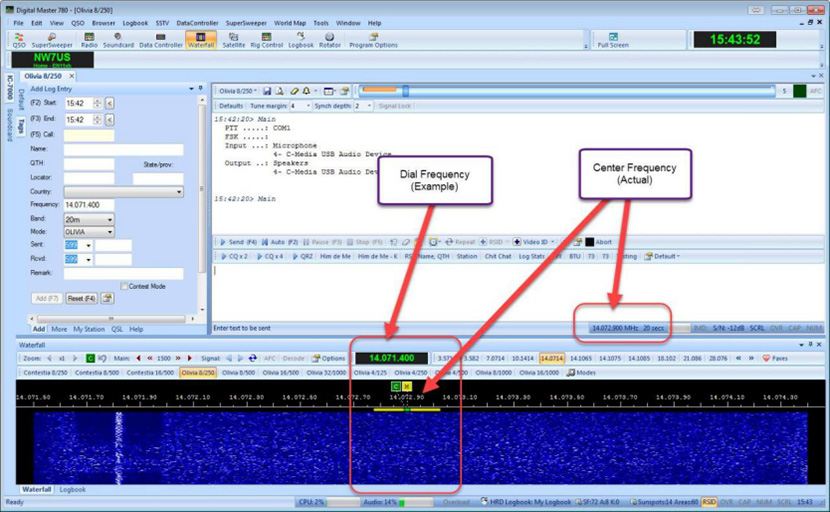
For those of you who have dived into the crowded but fun pool of FT8 operation--or one of the other Joe Taylor modes (such as JT65, FT8, or JT9)--and now are excited about digital modes, here's something you might enjoy exploring, as well. Unlike the JT/FT digital modes--modes that do an incredible job under marginal propagation conditions--there are other modes that offer keyboard-to-keyboard conversational QSO opportunities that can overcome rough shortwave radio propagation conditions.
(The meaning of QSO on Wikipedia: An amateur radio contact, more commonly referred to as simply a "contact", is an exchange of information between two amateur radio stations.)
While making quick work of getting DX stations into your logbook by exchanging callsigns, a signal report, and a grid square, the JT/FT modes (JT stands for Joe Taylor, the fellow that pioneered these modes) are limited. They cannot handle any additional communications beyond a callsign, a signal report, a grid square, and a very limited set of acknowledgements and sign-off messages. When you desire to get to know people from other areas of the world, or if you need to establish networks around the world for passing information--perhaps an emergency net in support of the Red Cross--or if you are motivated by any other of a myriad reasons to establish a keyboard-to-keyboard conversation by way of the ionosphere, modes like Olivia are great candidates for your consideration. (Later in this article, typical and suggested frequencies and settings are listed for Olivia operation on HF)
For Your Consideration: Olivia
Olivia is an MFSK--Multi-Frequency Shift Keying--radioteletype protocol designed to work in difficult conditions on shortwave bands. The Olivia digital mode is commonly used by amateur radio operators to reliably transmit ASCII characters over noisy channels using the high frequency (i.e., 3 MHz to 30 MHz; high-frequency, or HF; shortwave) spectrum. The typical Olivia signal is decoded when the amplitude of the noise is over three times that of the digital signal!
In 2005, SP9VRC, Pawel Jalocha, released to the world Olivia, a mode that he developed starting in 2003 to overcome difficult radio signal propagation conditions on the shortwave bands. By difficult, we are talking significant phase distortions, low signal-to-noise ratios (SNR), and multipath propagation effects. The Olivia-modulated radio signals are decoded even when it is ten to fourteen dB below the noise floor. That means that Olivia is decoded when the amplitude of the noise is slightly over three times that of the digital signal!
When the propagation of digital signals is sub-optimal, such as when the signal experiences low signal-to-noise ratio, and/or the path between the transmitting station and receiver experiences multipath propagation, many digital modes suffer the loss of data. Olivia, on the other hand, overcomes these problems.
Olivia decodes well under other conditions that are a complex mix of atmospheric noise, signal fading (QSB), interference (QRM), noise (QRN), and polar flutter caused by a radio signal traversing a polar path. Olivia is even capable when the signal is affected by auroral conditions (including the Sporadic-E Auroral Mode, where signals are refracted off of the highly-energized E-region in which the Aurora is active).
Currently, the only other digital modes that match or exceed Olivia in their sensitivity are MT63, and some of the modes designed by Joe Taylor as implemented in the WSJT programs, including FT8, JT65A, and JT65-HF--each of which are certainly limited in usage and definitely not able to provide true conversation capabilities. Olivia is useful for emergency communications, unlike JT65A or the newly popular FT8.
Olivia in Action
There is Olivia activity on shortwave. The mode has not died out, or become obsolete! This document is the result of many discussions between members of a subset of Olivia communicators. We are advocates and participants of the Olivia digital mode on HF:
Join us on Facebook at https://www.Facebook.com/groups/olivia.hf
Join us on Groups.io via http://OliviaDigitalMode.net
The following link is to a video that is a demonstration of a two-way transmission (a QSO) using the Olivia digital mode on shortwave. I am in QSO (conversation) with KA5TPJ. As you can see on the waterfall (the deeper blue area toward the bottom of the software's window), there are two other Olivia QSOs just below my QSOs frequency. Just above my QSO frequency is FT8 activity. Below the two other Olivia QSOs are PSK31 QSOs. The band is active. One thing stands out: Olivia is not dead!
https://www.youtube.com/watch?v=yAIhkaJN15o
The standard Olivia formats (shown as the number of tones/bandwidth in Hz) are 8/250, 8/500, 16/500, 8/1000, 16/1000, and 32/1000. Some even use 16/2000 for series emergency communication. The most commonly used formats are 16/500, 8/500, and 8/250. However, the 32/1000 and 16/1000 configurations are popular in some areas of the world (Europe) and on certain bands.
These different choices in bandwidth and tone settings can cause some confusion and problems--so many formats and so many other digital modes can make it difficult to figure out which mode you are seeing and hearing. After getting used to the sound and look of Olivia in the waterfall, though, it becomes easier to identify the format when you encounter it. To aid in your detection of what mode is being used, there is a feature of many digital-mode software implementation suites: the RSID. The next video, below, is a demonstration on how to set the Reed-Solomon Identification (RSID) feature in Ham Radio Deluxe's Digital Master 780 module (HRD DM780). (Check out Ham Radio Deluxe, here.)
I encourage ALL operators, using any digital mode such as Olivia, to TURN ON the RSID feature as shown in this example. In Fldigi, the RSID is the TXID and RXID; make sure to Check (turn on) each, the TXID and RXID.
Please, make sure you are using the RSID (Reed Solomon Identification - RSID or TXID, RXID) option in your software. RSID transmits a short burst at the start of your transmission which identifies the mode you are using. When it does that, those amateur radio operators also using RSID while listening will be alerted by their software that you are transmitting in the specific mode (Olivia, hopefully), the settings (like 8/250), and where on the waterfall your transmission is located. This might be a popup window and/or text on the receive text panel. When the operator clicks on that, the software moves the waterfall cursor right on top of the signal and changes the mode in the software. This will help you make more contacts!
https://www.youtube.com/watch?v=lBIacwD9nNM
NOTE: The MixW software doesn't have RSID features. Request it!
Voluntary Olivia Channelization
Since Olivia signals can be decoded even when received signals are extremely weak, (signal to noise ratio of -14db), signals strong enough to be decoded are sometimes below the noise floor and therefore impossible to search for manually. As a result, amateur radio operators have voluntarily decided upon channelization for this mode. This channelization allows even imperceptibly weak signals to be properly tuned for reception and decoding. By common convention amateur stations initiate contacts utilizing 8/250, 16/500, or 32/1000 configuration of the Olivia mode. After negotiating the initial exchange, sometimes one of the operators will suggest switching to other configurations to continue the conversation at more reliable settings, or faster when conditions allow. The following table lists the common center frequencies used in the amateur radio bands.
Olivia (CENTER) Frequencies (kHz) for Calling, Initiating QSOs
It is often best to get on standard calling frequencies with this mode because you can miss a lot of weak signals if you don't. However, with Olivia activity on the rise AND all the other modes vying for space, a good deal of the time you can operate wherever you can find a clear spot--as close as you can to a standard calling frequency. Note: some websites publish frequencies in this band, that are right on top of weak-signal JT65, JT9, and FT8 segments. DO NOT QRM weak-signal QSOs!
We (active Olivia community members) suggest 8/250 as the starting settings when calling CQ on the USB frequencies designated as 'Calling Frequencies.' A Calling Frequency is a center frequency on which you initially call, 'CQ CQ CQ...' and then, with the agreement of the answering operator, move to a new nearby frequency, changing the number of tones and bandwidth at your discretion. Even though 8/250 is slow, the CQ call is short. But, it is narrow, to allow room for other QSOs nearby.
OUR CURRENT (2018) SUGGESTED OLIVIA CALLING AND LISTENING FREQUENCIES
These are suggested frequencies on which can be found WEAK (i.e., a signal that you cannot hear, a signal not seen on the waterfall) Olivia signals. While it is easy to spot a STRONG Olivia signal anywhere on the waterfall, by using these suggested calling frequencies at least once and a while, you will enable us to find your signal when the signal is too weak to hear and too faint to see on the waterfall. Olivia can do well with weak signals. Yes, our suggested 8 tone with 250 Hz bandwidth results in slow transmissions. But, it is one of the better settings when attempting to decode very weak signals. Once you make contact, you can move up or down a bit, away from the calling frequency, and then change to 16/500 to make the conversation go faster. But, on a calling frequency, it is advisable to configure operations in such a way as to increase the likelihood that you will find and decode that weak signal.
In the following list, CENTER is where you place the center of the software's cursor, and click to select that center frequency on the waterfall. If you use the DIAL frequency from this list, then click 1500 Hz offset up the waterfall (1500 Hz to the RIGHT of the LEFT side of the waterfall, if your waterfall is oriented horizontally with the lowest frequency on the left). This results in the software and transceiver being correctly tuned for the CENTER frequency. The listing shows CENTER, then DIAL, then the number of tones and the bandwidth.
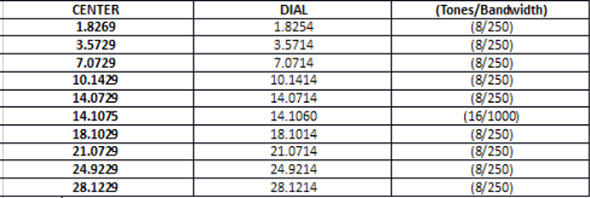
And so on.
Below, our current frequency reference listing: http://NW7US.us/images/2018-03-03_SuggestedFreqs.jpg
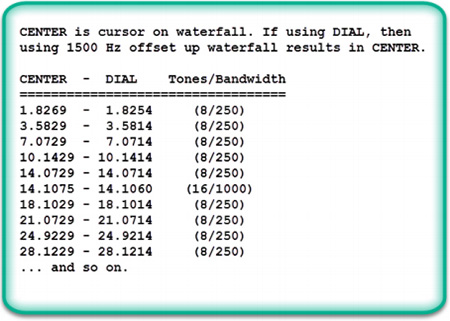
Example (screen grab showing an example):
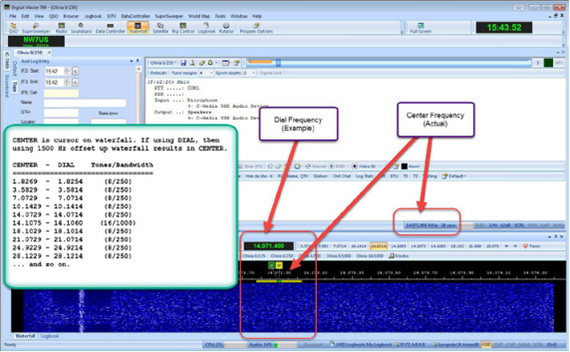
REMEMBER THAT IF YOU USE THE DIAL FREQUENCY (THE SECOND FREQUENCY PER ROW), SET YOUR WATERFALL CENTER AT 1500 Hz.
Don't forget: If your software is able to decode/encode the Reed-Solomon Identification signals (RSID), please turn on both received and transmit RSID. An example is shown in the following video, which demonstrates enabling RSID in a popular software suite: https://www.youtube.com/watch?v=lBIacwD9nNM
Please share this everywhere possible, as part of our effort to rekindle the love for our conversational mode, Olivia.
Q: What's a 'CENTER' Frequency? Is That Where I Set My Radio's Dial?
For those new to waterfalls: the CENTER frequency is the CENTER of the cursor shown by common software. The cursor is what you use to set the transceiver's frequency on the waterfall. If your software's waterfall shows the frequency, then you simply place the cursor so that its center is right on the center frequency listed, above. If your software is set to show OFFSET, then you might, for example, set your radio's dial frequency to 14.0714, and place the center of your waterfall cursor to 1500 (1500 Hz). That would translate to the 14.0729 CENTER frequency.
Another operating tip: Do not switch to other modes or settings without calling CQ for at least a five-minute window. It is horrid when people call CQ and change settings, modes, bandwidths, tones, every time they call CQ! If you want someone to answer your CQ, you need to stick with one setting for long enough for others to find your signal and get set up to answer.
REMEMBER: ALWAYS TURN ON RSID!
(TXID and RXID in FLdigi)
Q: What are the common windows of Olivia operation on HF (this is still a work-in-progress; your input is welcome)
+ 160m: 1835 kHz - 1837.9 kHz
+ 80m: 3571 kHz - 3573.9 kHz
+ 40m: 7071 kHz - 7073.9 kHz (500, 250, or 125 Hz configurations mostly)
+ 30m: 10141 kHz - 10144 kHz (500, 250, or 125 Hz configurations mostly)
+ 20m: 14071 kHz - 14073.9 kHz (500, 250, or 125 Hz configurations mostly)
+ 20m: 14104.5 kHz - 14107.9 kHz (1000 or 2000 Hz wide configurations mostly)
+ 17m: 18102.65 kHz
+ 15m,
12m,
10m,
6m: Usually 500 Hz above PSK activity (i.e., 21071.5 kHz, 24921.5 kHz, 28121.5 kHz)
+ 6m: 50.291 MHz (?? still in debate)
Note: Make sure that your signal does not cross into other sub-bands (watch the highest edge of the transmitted signal) where weak-signal modes are active. For instance, do not have any part of your signal at 14074 kHz or higher, as this is the sub-band for FT8, which is just below JT65A and JT9.
Also, do not quickly switch to other modes without calling CQ for at least a five-minute window. It is really horrid when people call CQ and change settings, modes, bandwidths, tones, every time they call CQ during the same session!
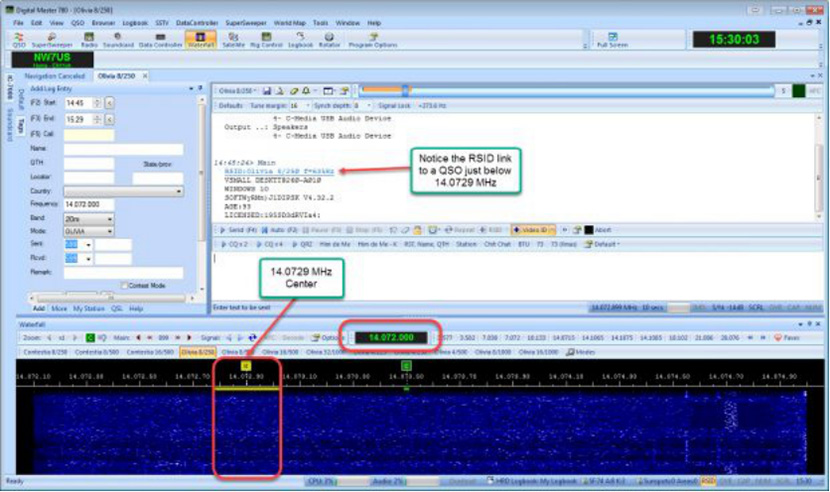
Join the OLIVIA COMMUNITY Online!
There are several key resources that we in the Olivia community are developing, to make it easier for you to enter the great world of Olivia. One is an active support e-mail group to which you can subscribe at https://groups.io/g/Olivia -- a group containing topical areas of interest which can be filtered so that you are not flooded by email containing topics of which you are not interested. It has a files section, as well, in which we will add helpful how-to instructions and so on.
Another resource is our Facebook group, at: https://www.Facebook.com/groups/olivia.hf -- also with a files area containing help files. This group is a great resource for getting help from like-minded Olivia digital mode enthusiasts.
Here is a video of an Olivia 80-Meter Roundtable Net:
https://www.youtube.com/watch?v=G7TlGEuStx4
Check out some eavesdropping on an Olivia QSO:
https://www.youtube.com/watch?v=2lv9dshac78
And, two more:
https://www.youtube.com/watch?v=FUjiBVsXrzE
https://www.youtube.com/watch?v=Yz7a--ePSNs
One last note: Olivia is NOT a weak-signal mode. There are no points won by barely making a contact. In the USA FCC regulations, you are directed to use only the power necessary to make the QSO. Typically, with poor propagation, using Olivia with an output power of 100w is the minimum to establish a reliable circuit. You just cannot go beyond your rig's duty cycle (don't burn out the finals in your radio!). You also must be sure that you do not overdrive the audio chain into your radio. Be sure that you do not have RF coming back into your audio chain. Yes, 100 watts is acceptable. Don't let anyone convince you otherwise.
Welcome to Olivia!
See you on the waterfall.
73 de NW7US
Tomas Hood (Amateur radio NW7US),
Twitter: @NW7US
YouTube: https://YouTube.com/NW7US
Home Website: http://me.NW7US.us
Categories that this topic belongs to: RIGblasters

